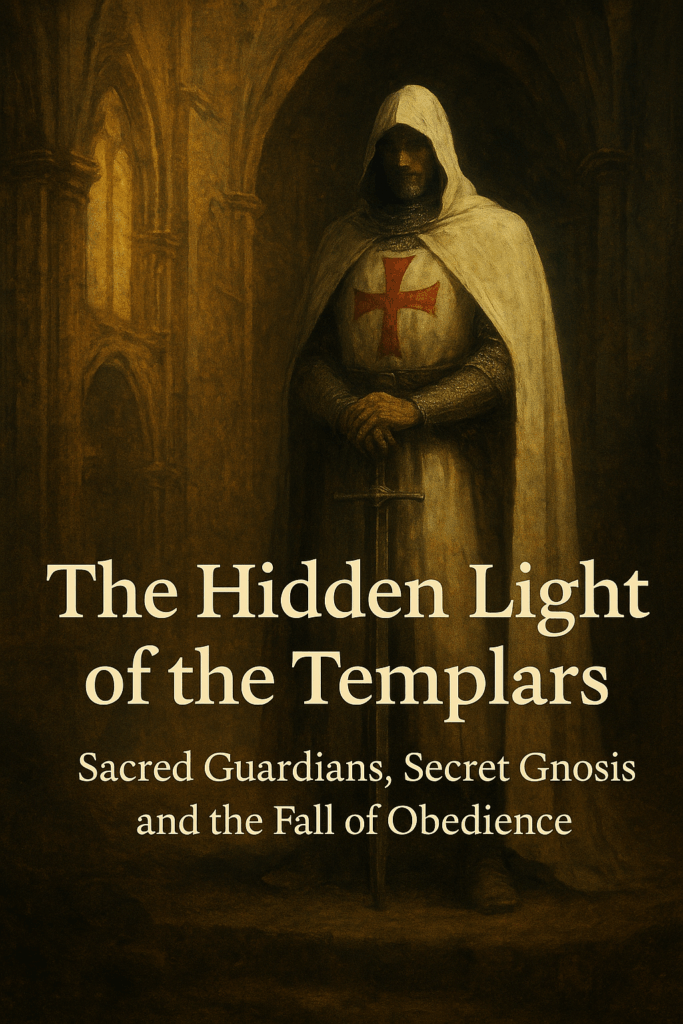A Sovereign Reflection Across Time — Part III: Sacred Guardians, Secret Gnosis, and the Fall of Obedience

Flames rise against the night sky. Robes torn, scrolls scorched, and silence shattered. The silence of those who once guarded a forgotten knowing—broken by fire and fear.
The Knights Templar are remembered as warrior monks, as the elite sword-arm of Christianity, as bankers and builders of empires. From Jerusalem to Chartres Cathedral, their influence stretched across sacred ground and stone. But history, like empire itself, is often written by those who feared what could not be controlled—especially those who dared to claim the sacred without the need for hierarchy.
This is not a story of piety or conquest.
This is the story of what they remembered.
The Rise of the Templar Order
Formed in the early 12th century to protect pilgrims in the Holy Land, the Templars quickly became something far greater. They amassed wealth, influence, and secrets—stretching from Jerusalem to Europe’s most powerful courts.
They were not simply knights. They were initiates—men whose outer vows masked inner revelations. They built not just fortresses, but cathedrals encoded with sacred geometry. They developed banking systems, independent networks, and inner rituals whispered behind stone walls.
And they stationed themselves at the heart of it all—on the Temple Mount in Jerusalem.
The Secrets Beneath the Stones
For nine years, the earliest Templars occupied the site believed to be the ruins of Solomon’s Temple. But what were they really guarding—or seeking?
There are whispers of scrolls hidden since the Essenes.
Others speak of gospels long erased by Rome—texts of Yeshua and Mary Magdalene that revealed the Kingdom Within.
Still others believe they remembered what the Church tried to bury:
That the Divine is not above—but within.
These weren’t relics of power. They were blueprints of sovereignty.
A Threat to the Church
The Templars, once obedient servants, had become something else. They were self-funded. Independent. They no longer needed papal permission to act—or to access the sacred.
And that made them dangerous.
The Church required obedience to maintain its authority. But the Templars had tasted direct knowing. Gnosis. The same flame that once moved through the early mystics now flickered within stone sanctuaries guarded by the sword.
They no longer served religion.
They served remembrance.
Friday the 13th: Betrayal by Flame
On October 13, 1307, under the order of King Philip IV of France—deeply in debt to the Templars—hundreds were arrested, tortured, and executed. Their leader, Jacques de Molay, was burned alive, refusing to confess to the heresies fabricated to justify their fall.
It was not just an execution.
It was an attempted erasure.
Not just of men—but of memory. Of a truth that could not be governed.
What They Remembered
Like the Assassins, the Templars had become Gnostic in essence.
They were not loyal to creed, but to a deeper current.
Their chapels held symbols of the Divine Feminine. Their rituals pointed inward, not upward. Their silence spoke of what could not be spoken in cathedrals built on control.
The red cross upon white robes was not only a symbol of crusade.
It was the mark of the blood and the womb—of life and death, sacrifice and rebirth.
The Sacred Union.
The Breath and the Body.
The Feminine Thread
Many now believe the Templars were not just guardians of territory—but of a hidden thread that wove through Magdalene, Sophia, and the lost gospels.
They may have carried the memory of Magdalene’s teachings.
Not the myth the Church created—but the Sovereign One who knew:
“I am not beneath Him. I walk with Him.”
This, too, was a threat.
For the return of the Feminine would unseat the entire hierarchy.
The Fall of Obedience
The Templars were burned, scattered, dissolved by decree.
But what they carried could not be destroyed.
You feel it now.
In architecture that stirs your soul.
In symbols that still whisper.
In dreams of sacred halls you’ve never seen, and in the silence that follows the breath—echoes from within your own inner temple.
They were not saints. Not saviors. Not martyrs.
They were fragments of a greater flame.
Sovereigns in silence, and their echo lives on in you.
And that flame has never gone out.
Closing Reflection
They knelt not to power, but to Presence.
And the light they carried was never theirs to own.
It lives now in the one who no longer obeys.
Not in rebellion—but in remembrance.
The Sovereign Flame cannot be burned.
